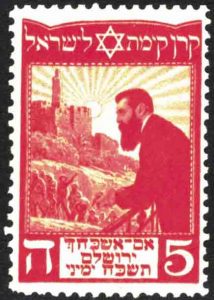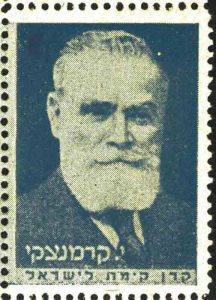Personalities of JNF/KKL
“Depicts Theodore Herzl (1860-1904) leaning on the rail of the balcony of the Three Kings Hotel in Baael, Switzerland at the time of the First Zionist Congress”
(Rochlin 10)
http://zionism-israel.com/bio/biography_herzl.htm (September 5, 2016)
Herzl probably first experienced anti-Semitism while studying at the University of Vienna (1882). He thought of the Jewish problem as a social issue and wrote a play, The Ghetto (1894), about the dilemma of Vienna Jewry, in which assimilation and conversion were rejected as solutions. He hoped that The Ghetto would lead to debate and ultimately to a solution, based on mutual tolerance and respect between Christians and Jews.
In 1894, Captain Alfred Dreyfus, a Jewish officer in the French army, was falsely accused and convicted of treason (See Dreyfus Affair ) . Mobs shouted “Death to the Jews” in France, the home of the French Revolution and the emancipation of the Jews. Herzl became convinced that the Jews needed a country of their own.
Herzl witnessed the Dreyfus affair as a newspaper correspondent. According to conventional accounts, his Zionism resulted from contemplating the persecution of Dreyfus. According to some others, he may have been more influenced by the election of the anti-Semitic Karl Luger as mayor of Vienna.
Herzl concluded that anti-Semitism was a stable and immutable factor, which assimilation would not solve, and which it was futile to combat. Despite ridicule from Jewish leaders, he published The Jewish State (Der Judenstaat) in 1896. Herzl claimed that the Jews could gain acceptance in the world only if they stopped being an anomaly among nations. He asserted that the scattered Jews are one people. Their plight could be transformed into a positive force by the establishment of a Jewish state guaranteed in international (public) law – “volkerrechtig” — with the consent of the great powers. Echoing Rabbi Yehudah Alkalai and a few other Zionist forerunners, Herzl saw the Jewish problem as an international political issue. His ideas were quite similar to those of Leon Pinsker, but he evidently was unacquainted with Pinsker’s Auto-Emancipation.
Herzl proposed to collect funds from Jews around the world by a company which would work toward settling Jews in Palestine. and securing a state. Eventually this idea was transformed into the Zionist Organization, the Jewish National Fund and other organizations. The Jewish State and Herzl’s novel, Altneuland (Old New Land) published in 1902, pictured a Jewish social utopia in Palestine. It would be a pluralist, technologically advanced, secular society with equality for Arabs. Altneuland became a symbol of the Zionist vision in the Land of Israel. It was translated into Hebrew almost simultaneously with the name “Tel-Aviv,” which soon became the title of the first Zionist city in Palestine.
Herzl’s ideas were rejected in Western Europe. Herzl was turned down by Jewish magnates such as Baron Hirsch and Baron Rothschild. Herzl then appealed to the people, organizing the First Zionist Congress in Basle, Switzerland, on August 2931, 1897. (see Theodor Herzl: Address to the first Zionist Congress ) The congress was historic not just for founding the Zionist movement, but because it was the first time an organized body , representing at least the Jews of the Western world, had been convened since the exile nearly 2000 years ago.
Herzl’s ideas found mass support from the poor Jews of Eastern Europe and Russia. At Basle, the Zionist movement resolved to ” establish a home for the Jewish people in Palestine secured under public law.” The Basle congress also resolved to set up a political organization and financial institutions to carry forward the Zionist idea. The World Zionist Organization was established, and Herzl was elected president. Herzl wrote in his diary, “At Basle, I founded the Jewish state.. If not in five years, then certainly in fifty, everyone will realize it.”
Herzl presided over six Zionist Congresses between 1897 and 1903, setting up the Jewish Colonial Trust, the Jewish National Fund and the movement’s newspaper Die Welt. After Herzl’s death, the movement continued to meet every year except during war.
Jonah Kremenetsky (Johann Kremenetzky) (Johann Kremenezky) (Yona Krementzky)
” . . . began publishing JNF stamps, the proceeds of which went into the fund.”
(Rochlin Ge 102)
Editor’s note: There are 4 different ways to spell his name: Jonah Kremenetsky (Johann Kremenetzky) (Johann Kremenezky) (Yona Krementzky).
Johann Kremenezky was born in Odessa (Ukraine) on February 2,1850. He earned a doctorate in electrical engineering. He first opened an electrical factory in 1880 in Vienna for dynamos and light bulbs. He subsequently expanded production into many other areas.
http://www.jnf.org/about-jnf/history/?print=t
One month after the fund was established, Yona Krementzky was appointed to head JNF-KKL, headquartered in Jerusalem, and he set to work immediately.
Krementzky initiated the Golden Book, which records special moments in the lives of inscribers, or those they wish to honor, with paid inscriptions which to this day remain a
coveted badge throughout the Jewish World. These beautiful books are housed at JNF-KKL headquarters in Jerusalem for all to see. The very first inscription was that of
Theodor Herzl.
Krementzky also began publishing JNF stamps, the proceeds of which went into the fund. These stamps were affixed to official Zionist documents as well as personal letters, and
many people collected them. The first stamp was issued in 1902 and showed the Star of David and the name “Zion.”
Krementzky also adopted the suggestion of a small-town Galician bank clerk, Haim Kleinman, who had written to the Zionist movement’s newspaper Die Welt, proposing that
a collection box be placed in every Jewish home so that contributions could be made to JNF at every opportunity. In the period between the two World Wars, about one million Blue Boxes could be found in Jewish homes throughout the world.


